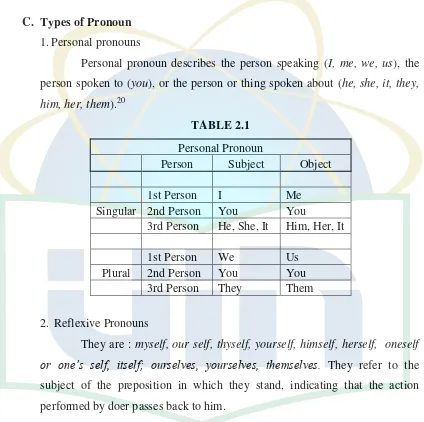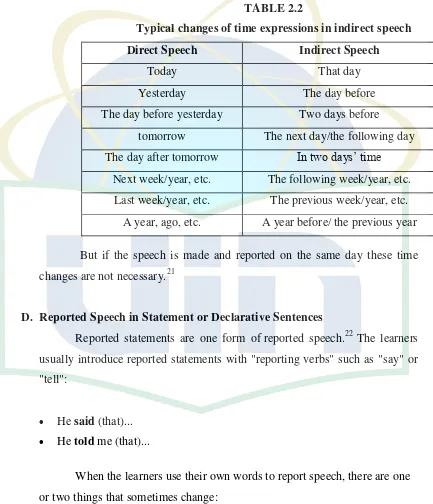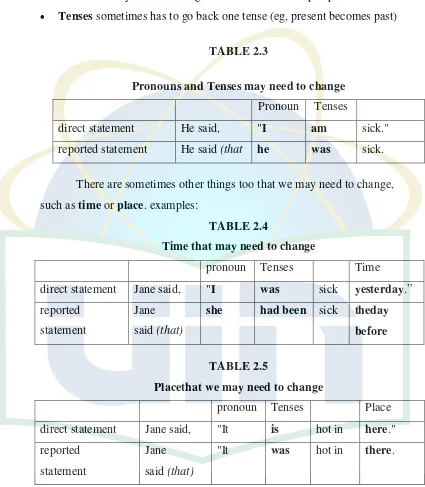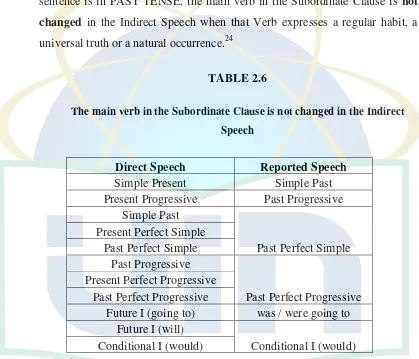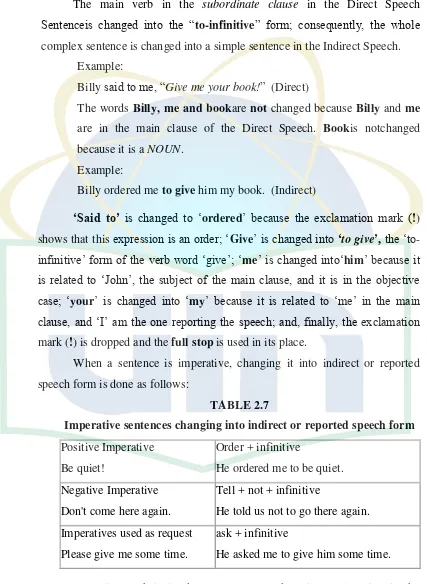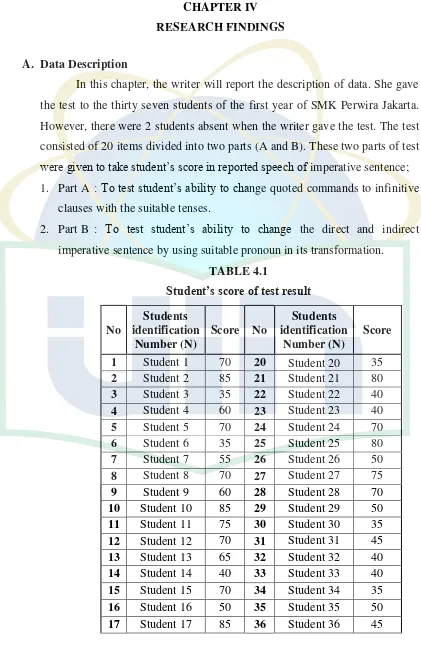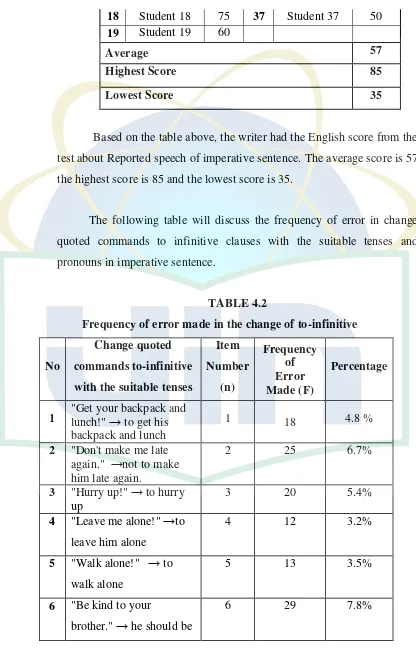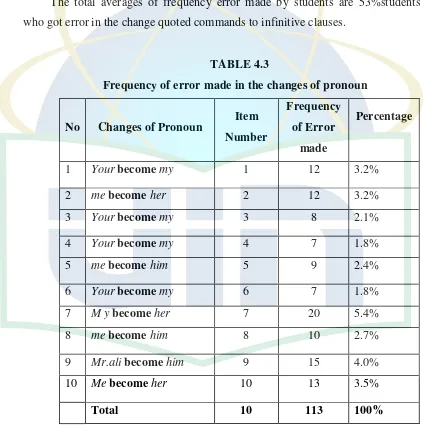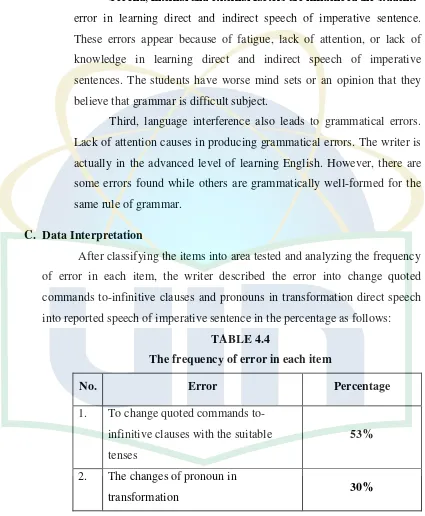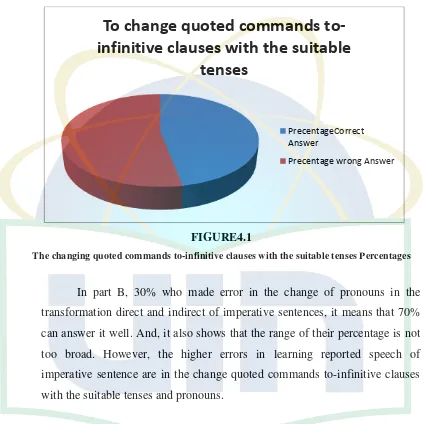( A Case of study at SMK Perwira Jakarta)
By : Dian Dzikraria
107014001479
DEPARTMENT OF ENGLISH EDUCATION FACULTY OF TARBIYAH AND TEACHERS TRAINING SYARIF HIDAYATULLAH STATE ISLAMIC UNIVERSITY
i
Dzikraria, dian. 2014, AN ERROR ANALYSIS IN LEARNING DIRECT AND INDIRECT SPEECH OF IMPERATIVE SENTENCES of the First Grade Senior
High School at SMK Perwira Ulujami Jakarta, Skripsi, English Education
Department, The Faculty of Tarbiyah and Teachers Training, Syarif Hidayatullah
State Islamic University Jakarta.
Advisor : Drs.Syauki, M.Pd
Keywords : Error Analysis, Reported Speech of Imperative Sentence
This research is aimed to obtaining the clear information about the level of
the students error in reported speech of imperatives sentence by using descriptive
analysis method. The sample of this research 37 students from 39 students
because two of students were absent of X AK-1 of the first grade students at SMK
Perwira Jakarta. To collect the data the writer gave a test and interview to know
why the students do in errors finding. The most students’ errors in changes quoted
commands to-infinitive with the suitable tenses, there are 53% who got errors.The
total averages of frequency error made by students are 30% who got error in the
change of pronoun. It can be explained that the students made errors because of
this inaccuracy caused by the incomplete application of rules, first language
ii
Dzikraria, dian. 2014, AN ERROR ANALYSIS IN LEARNING DIRECT AND INDIRECT SPEECH OF IMPERATIVE SENTENCES of the First Grade Senior
High School at SMK Perwira Ulujami Jakarta, Skripsi, English Education
Department, The Faculty of Tarbiyah and Teachers Training, Syarif Hidayatullah
State Islamic University Jakarta.
Advisor : Drs.Syauki, M.Pd
Keywords : Error Analysis, Reported Speech of Imperative Sentence
Penelitian ini bertujuan untuk mendapatkan informasi yang jelas tentang
tingkat kesalahan siswa dalam reported speech of imperative sentence dengan
menggunakan metode deskriptif. Sampel penelitianini di ambil dari 37 siswa dari
total 39 siswa dikarenakan 2 orang siswa tidak masuk. Bertempatan dikelas X
AK-1 dari siswa kelas satu di SMK Perwira Jakarta. Untuk mengumpulkan data
penulis memberikan tes dan wawancara untuk mengetahui mengapa siswa
melakukan kesalahan. Kesalahan yang paling banyak siswa lakukan adalah dalam
perubahan kalimat perintah to-infinitive dengan tenses yang sesuai, terdapat 53%
yang mendapat errors .Total rata-rata dari frekuensi kesalahan yang dibuat oleh
siswa adalah 30% yang mendapat kesalahan dalam perubahan pronoun. Hal ini
dapat menjelaskan bahwa siswa melakukan kesalahan karena ketidak telitian yang
disebabkan aplikasi yang tidak lengkap dari aturan, gangguan bahasa pertama, dan
iii
In the name of Allah, The Beneficient, the Merciful.
All praise be to Allah, Lord of the Worlds, who has bestowed strength and
health upon the writer in writing this “skripsi’. Peace and blessing be upon our
prophet Muhammad, his family, companions, and all his followers.
First of all, the writer would like to express her greatest honor and love to
her beloved family: her parents ( father As. Syakur and mother Siti Jawiyah) for
their best support, prayer and motivation, and all members of the family who
always give their love, care, and moral encouragement to finish her study.
The writer would like to express her greatest thankfulness and gratitude to
her advisor Drs.Syauki, M.Pd for his valuable help, guidance, comments,
corrections and suggestions and who has been very patient to assist her so that the
writer could finish writing this “skripsi”.
Furthermore, her greatest gratitude also goes to :
1. All lecturers of English Education Department who have taught her new
knowledge and have given her gorgeous experiences in study.
2. Drs. Syauki, M.Pd. and Neneng Sunengsih S.Pd., the head and secretary of
English Education Department.
3. Dra Nurlena Rifa’I, M.A. Ph.d., the Dean of Faculty of Tarbiyah and Teachers
Training.
4. The principal and the English teacher of Senior High School (SMK) Perwira
Jakarta for permitting and helping the writer to conduct the research.
5. All her beloved friends whose name cannot be mentioned one by one who
iv
shortages. Thus, she would be grateful to accept any suggestions and
corrections from anyone for better writing.
Jakarta, April 2014
v
ABSTRACT ... i
ABSTRAK ... ii
ACKNOWLEDGEMENT ... iii
TABLE OF CONTENTS ... v
LIST OF TABLES ... vii
LIST OF FIGURES ... viii
LIST OF APPENDICES ... ix
CHAPTER I: INTRODUCTION A. The Background of the Study ... 1
B. Identification of the Problem ... 4
C. Limitations of the Study ... 4
D. The Formulations of problem ... 4
E. The Objective of Study ... 5
F. Significant of Study ... 5
CHAPTER II: THEORITICAL FRAMEWORK A. Error and Error Analysis ... 6
a. Concept of Error ... 6
b. Error Analysis ... 7
c. The Cause of Error ... 8
d. Types of Error ... 10
e. The Procedure of Error Analysis ... 12
B. Reported Speech ... 13
a. Meaning of Reported Speech ... 13
b. The Kind of Speech ... 14
vi
f. Reported Speech in Imperative Sentences ... 22
CHAPTER III: RESEARCH METHODOLOGY A. The Purpose of the research ... 27
B. Time and Places of the study ... 27
C. Population and sample of the study ... 27
D. Method of the study ... 27
E. Instrument of the research ... 28
F. Technique of data analysis ... 28
CHAPTER IV: RESEARCH FINDINGS A. Data Description... 30
B. Data Analysis ... 36
C. Data Interpretation ... 38
CHAPTER V: CONCLUSION AND SUGGESTION A. Conclusion ... 42
B. Suggestion ... 43
vii
2. Table 2.2 Typical changes of time expressions in indirect speech ... 18
3. Table 2.3 Pronouns and Tenses may need to change ... 19
4. Table 2.4 Time that may need to change ... 19
5. Table 2.5 Place that we may need to change ... 19
6. Table 2.6The main verb in the Subordinate Clause is not changed in the Indirect Speech ... 20
7. Table 2.7 Imperative sentences changing into indirect or reported speech form ... 27
8. Table 4.1 Student’s score of test result ... 30
9. Table 4.2 Frequency of error made in the change of to-infinitive ... 32
10.Table 4.3 Frequency of error made in the changes of pronoun ... 34
viii
suitable tenses Percentages ... 39
2. Figure 4.2 The changes of pronoun in transformation Percentages ... 40
3. Figure 4.3 Frequency of error made in the change of to-infinitive ... 40
ix
2. APPENDIX 2 Kisi – kisi Instrument
3. APPENDIX 3 Test and Answer
4. APPENDIX 4 Hasil wawancara guru
5. APPENDIX 5 Hasil wawancara siswa
6. APPENDIX 6 Surat Bimbingan Skripsi
7. APPENDIX 7 Surat Permohonan Izin Penelitian
1 A. The Background of Study
As international language, English takes an important rules in the world.
Due to the important of understanding English as international communication,
the Ministry Education of Indonesia includes English as foreign language that
students need to learn. English becomes a compulsory subject to teach started
from primary school until university.
Considered as foreign language, English has different grammatical rules
from Indonesia language. Therefore, some students get hard to learn English
Grammar. Especially English has different change verb tense that Indonesian language doesn’t have. It results many students who try learnt English cannot avoid to make mistake or error in their learning process.
Based on the writer experience in learning English, grammar is one of the
most difficult aspects other than any skills. Because it has many tenses, structure,
and pattern form that the writer should know and put on the right place. Not only
the writer but other students who try to learn English have a same problem.
However grammar is very important within the English Language, since it
is in effect the glue that holds the language together. With the use of incorrect
grammar sentences can become meaningless and their message is unclear.1 For
example, if the learners speaking or writing in a grammatically incorrect manner
can be just as confusing as trying to understand a foreign language can be. It is
important to use their words properly in order to get their point across effectively,
and practicing good basic grammar can also add credibility to what they say and
write.
1
According to Marianne Celce Murcia and Diane Larsen “Grammar and rhetoric books generally recognize three ways for speaker and writer to attribute
statements or thought to other people: direct quotation, indirect reported speech, paraphrase.”2
Direct and indirect speeches are one of many grammatical categories
which is important to be learnt by students. The students need to learn because it
is one of three ways for students to report or share their statments or thought to
other people especially when they communicate between each other.
Michael Swam stated in Practical English Usage that reported speech are
spoken or thought in one place by one person may be reported in another place at
a different time, and perhaps by another person3
Sometimes students speak to others in practical communication, it means that students have to recite one’s saying. When students in practical communication in English it will have imperative and discussion in direct and
indirect speech. The students should know all about Direct and Indirect Speech
because all these sense Direct and Indirect Speech in imperative sentence are still
being used in wrong pattern.It can be concluded from statement above, that the
grammatical changes which happened when the direct form transformed into
indirect form has become one of difficulties that occur when the students learn
reported speech. Therefore, it is important for students to have a good
understanding on it and memorize the rule or form very well.
Brown Said that ”second language learning is a process that is clearly not unlike first language learning in its trial and errors nature”. It means that the learners cannot avoid errors in learning second language.4
2
Marianne Celce and Diane Larsen, The Grammar Book an ESL/EFL Teacher’s Course, (New York: Heinle Publisher, 1999),2nd ed, p.68.
3
Michael Swan, Practical English Usage, (Oxford University Press, 1980),p.481.
4
The students often make mistakes and even errors in learning
Englishespecially in reported speech of imperative sentences, for example the
students are still confused bychanges of tenses and pronoun that can occur in
reported speech. Error always occurs although the best effort has been done.
Therefore, when they try to speak or write the target language, it is inevitable for
them to produce many errors.Making Errors are a natural in English learning
process learning.
In process of learning English, the students’ errors are very useful ways of
showing what they have and have not learnt. By learning reported speech the
students will learn and understand the way to report speeches such as statement,
question and imperative. But in this paper the writer focuses on reported speech of
imperative sentences.
The writer assumes that students will absorb grammar rules as they hear,
read, and use the language in communication activities especially in reported
speech of imperative sentence. The students strategy does not allow them to use
one of the major tools they have as learners. The students actively try to
understand of what reported speech of imperative is and how it works in the
language they have already known.
To turn direct speech into indirect speech in right form needs changing of
tenses, pronouns, word order and adverbs. Beside, those are divided into three
kinds: statement, question, and imperative. Probably it can cause students get
confusion to understand direct and indirect speech material. Therefore this study
focuses on the errors in direct and indirect speech of imperative sentences made
by students of SMK Perwira.
Based on description above, the writer would like to conduct the research
on the students errors in learning reported speech. This study is done in first year
students of SMK Perwira. So the writer would like to discuss it in this “skripsi”
“ AN ERROR ANALYSIS IN LEARNING DIRECT AND INDIRECT SPEECH OF IMPERATIVE SENTENCES ( A Case of study at SMK Perwira
Jakarta)”
B. The Identification of Problem
Based on the background of the study above, there are many problems that
can be identified in this research such as:
1. The problem of changes tenses
2. The problem of changes pronoun
3. The problem of changes adverb
4. The problem of grammatical changes
5. The problem of usingwrong form and usage in direct and indirect
speech of imperative
6. Poor vocabularies
C. The Limitation of study
It is important to make limitation in order to clarify the problems. This
study focuses on errors in direct and indirect speech of imperative sentence at
SMK Perwira Jakarta.
D. The Formulation of problem
Based on the background described above, this study intends to formulate
the problems as follows:
1. What are the most common types of errors that students made in direct
and indirect speech of imperative sentence?
2. What are the reasons of students’ error?
E. The Objective the study
Based on the formulation of problem above, the objective of this study as
bellow:
1. To get the most common of types of errors made by students at SMK
Perwira in direct and indirect speech of imperative sentence.
2. To find out the students cause of errors made by the students.
3. To find out the students difficulties in direct and indirect speech.
F. Significant of study
The result of this study is expected can be benefit for the writer herself
particularly to improve her perception of error analysis and for anyone who reads
this paper generally. Moreover for the students of English Education, they can
6 A. Error and Error Analysis
1. Concept of Error
Dullay stated “Error are the flawed side of learner side of learner speech of writing”.1
Its mean that there is something wrong in norms of
language performance. But most of the people stil misunderstand about the
definitions of both.
Depend on the writer opinion, error and mistake are not same. Errors
are a noticeable and cannot be self corrected and mistake is the opposite.
They are deviations from the adult grammar of native speakers, and reflect
the competence in the target language.
According to Taylor “The only way we can reasonably determine whether a mistake is slip or a genuine error is reference to the writers semantic and structural intentions”.2
Making Errors for the learners are a natural and unavoidable part of the
process of learning English. Many kinds of errors arise when the learners
write because they do not master the English structure well. Also, errors are
the inability of the students in using rules of the components and elements of
the second language.
Brown Said that ”second language learning is a process that is clearly not unlike first language learning in its trial and errors nature”. It means that the learners cannot avoid errors in learning second language.3
1
Heidi Dullay, Language Two, (New York, Oxford University Press,1982),p.139
2
John Norrish, Language Learners and their Errors, The Macmillan Press Limited,1983),.p77
3
So almost the learners must make errors when they are learning
English because it is difficult to separate error in the process of learning
English.
The writer assumed about some problems that the learners are having
now and help the teacher to plan remedial work. In addition, the teacher
should not see negatively as a sign of failure but see them positively as an
indication of what the teacher still needs to teach.So, if the teacher tries to
prevent students; errors, the students never finds out what they do not know.
2. Error Analysis
Errors Analysis assumed a new role in applied linguistics, it was
applied to new issues and questions within second language acquisition
research. Thestudy of errors in non-native language performance. It will
consider three perspectives reviewing the use of Error Analysis: (1) to
account for linguistic competence; (2) to identify learning processes and
strategies, and (3) to provied input to language pedagogy.4
Error is something difficult to avoid for beginner in learning language
process, it is natural part of language learning. Learning the second language
is a process unlike learning the first language, learner will directly connect
with such vocabulary, a new grammatical pattern and foreign pronunciation
which different from the first language. Error always occurs although the best
effort has been done. Therefore, when they try to speak or write the target
language, it is inevitable for them to produce many errors.
According to Jack Fisiak “to define „error’ in a formally rigorous and
pedagogically insightful way or to systematically account for the occurrence
of errors either in linguistic or psychological terms.5 It is a way of looking at
errors made by the learners of the target language. Error analysis is an
independent source of valid data. It provides information on students’ errors,
which in turn helps teachers to correct students’ errors, and also improves the
4
http://journals.cambridge.org/action/displayAbstract?fromPage=online&aid=2641948
5
effectiveness of their teaching. Apparently errors give sign to teacher and
researchers how target language learning is successfully achieved. According to Pit Corder as quoted by Brown: „A learner’s errors are significant [that] they provide the researcher the learner is employing in the discovery of the
language.6
Corder explained, “Our object in error analysis is to explain error
linguistically and psychologically in order to help the learner to learn”7
Guntur Taringan said: “Analysis kesalahan adalah suatu prosedur kerja, yang biasa digunakan oleh para peneliti dan guru bahasa, yang
meliputi pengumpulan sample pengidentifikasian yang terdapat dalam
sample, penjelasan kesalahan tersebut, pengklasifikasian kesalahan itu
berdasarkan penyebabnya, serta pengevaluasi antara keseriusan kesalahan
itu”8
To be more detail, Sharma explained,” Error analysis is defined as a process based on analysis of learners error with the one clear objective
evolving a suitable and effective teaching learning strategy and remedial
measure necessary in certain clearly market out areas of the foreign
language.9
From some statements above, it can be seen that errors in learning a second language are caused by the interference of the learners’ mother tongue. In other words, errors made the learners sometimes are caused by
use of the first language. So, the writer tries to conclude that error analysis is
a way of looking at error made by the learner of the target language.
3. The Cause of Error
One of the first and most important studies conducted in the field
of Error Analysis was the one done by Richards. His study involved learners
6
Brown,op.cit.,p.217
7
S. Pit Corder , Technique in Applied linguistic, (Oxford University Press, 1974),p.139
8
http://journals.English%20Training%20Center%20%20Error%20Analysis.htm
9
from different language background and showed the different types of errors
relating to production and distribution of verb groups, prepositions, articles,
and the use of questions. Based on this, he distinguished three sources of
errors:
a. Interference errors: errors resulting from the use of elements from one
language while speaking or writing another.
b. Intralingual errors: errors reflecting general characteristics of the rule
learning such as faulty generalization,incomplete application of rules and
failure to learn conditions under which rules apply
c. Developmental errors: errors occurring when learners attempt to build up
hypothesis about the target language onthe basis of limited experiences.10
According to Richards intralingual errors are also divided to the
following categories:
a. Overgeneralization errors: the learner creates a deviant structure on
the basis of other structures in the targetlanguage
b. Ignorance of rule restrictions: the learner applies rules to context
where they are not applicable
c. Incomplete application of rules: the learner fails to use a fully
developed structure
d. False hypothesis: the learners do not fully understand a distinction
in the target language.
James in his study, showed the different types of learners' errors
relating to omission, overinclusion,misselection use wrong words not wrong forms,
misordering, blends or blending arises when two alternative grammatical forms are
10
combined to produce an ungrammatical blend.Based on this, he stated that there are four
causesof errors.11
a. Interlingual errors (Mother-tongue influence): these kinds of errors
are influenced by the native languages which interfere with target
language learning
b. Intralingual errors: those due to the language being learned target
language
c. Communication strategy-based errors which are subdivided into the
holistic strategies or approximation and analytic strategies or
circumlocution
d. Induced Errors: these errors are the result of being misled by the way in which
the teachers give definitions, examples, explanations and arrange
practice opportunities. In other words, the errors are caused mostly
by the teaching and learning process as follows: Materials-induced
errors, Teacher-talk induced errors, Exercise-based induced errors,
Errors induced by pedagogical priorities, Look-up errors.
The writer concluded that the errors made by the students were both from
the intralanguage andinterlanguage interference. This is while the errors
caused by mother tongue interference were in a small proportion.
4. Types of Error
Dulay, Burt, and Krashen said that errors are the flawed side of learner
speech or writing. Students cannot learn languages without first systematically
committing errors. There are four descriptive taxonomies to analyze errors12,
there are:
11
Carl James, Error in Language Learning and Use, (New York ,Longman Inc, 1998), p. 179
12
a. Linguistic category taxonomy which classifies errors according to
either or both the language component (phonology, syntax,
morphology, semantics, and discourse).
b. Surface strategy taxonomy which high lights the way surface
structures are altered (omission, addition, misinformation, and
misordering).
c. Comparative taxonomy which classifies errors based on comparison
between the structure of language learner errors and certain other types
of construction.
d. Communicative effect taxonomy which deals with errors from the
perspective of their effect on the listener or reader.
According to Richards intralingual error types are caused by the target
language itself like:
a. False analogy, misanalysis or learners form a wrong hypothesis,
b. Incomplete rule application this is the converse of overgeneralization
or one might call it under generalization as the learners do not use all
the rules
c. Exploiting redundancy this error occurs by carrying considerable
redundancy. This is shown throughout the system in the form of
unnecessary morphology and double signaling
d. Overlooking co-occurrence restrictions this error is caused by
overlooking the exceptional rules
e. Hypercorrection or monitor overuse this results from the learners’ over
cautious and strict observance of the rules
f. Overgeneralization or system simplification this error is caused by
the misuse of words or grammatical rules
Error analysis does not regard as the persistence of old habits but
rather as sign that learner is internalizing and investigating the system of the
5. The Procedure of Error analysis
Error analysis is proposed as a means to supplement diagnostic
techniques with exceptional students. A purpose and definition of error
analysis are provided. Also, procedures to use error analysis are explained
along with basic guidelines to prevent abuse of error analytic techniques. Pit
Corder as quoted by Rod Ellis suggest the following steps in error analysis
research13, there are:
a. Collection of a sample of learner language. this step depends on
correct interpretation of the learners intentions. It can be arrived by
teachers interpretation.
b. Identification of error. Here one needs to distinguish between true
errors and slips. Errors can be "overtly idiosyncratic" (ill-formed in
terms of target language rules) or "covertly idiosyncratic" (sentences
superficially well-formed but when taking the context into account
they are clearly ungrammatical).
c. Description of error. This involves assigning a linguistic classified to
each error.
d. Explanation of error.In this stage of the procedure, an attempt is made
to identify the psycholinguistic cause of the errors.
e. Evaluation of error.This stage involves assessing the seriousness of
each error in order to make principled teaching decisions which are to
be processed in step.
The steps that learners follow get the researcher and language
teachers realize that if the mistakes or errors of language learners in
constructing the new language system are analyzed carefully.
13
B. Reported Speech
1. Meaning of Reported Speech
In English grammar, reported speech is one of many grammatical
categories which is important to be learnt by students. It is needed to be learnt
because it is one of three ways for students to report or share their statements
or thoughts to other people especially when they communicate between each
other.
Reported speech is commonly used to report what other people have
said or thought without reporting the exact word. With indirect reported
speech, one wishes to report the content of the original source without
necessarily repeating sentences exactly as they were originally uttered.14
To report people word’s, thoughts, and beliefs there are two main ways: direct and indirect speech. Reported speech is also used when people
are interested not in the words that someone has chosen, but in the essential
information they conveyed.
Reported speech can be found in newspaper reports, fiction, talking or
writing about conversation, reports, articles or speeches peoples have heard or
read. By learning reported speech definitely students will able to quote somebody’s words or thoughts, whether in direct or indirect speech and also the students will learn and understand the way to report speeches such as
statements, questions and imperative.
Reported Speech refers to reproducing the idea of another person’s
words. Not all of the exact words are used verb forms and pronoun may
change.
Michael Swam stated in Practical English Usage that reported speech
are spoken or thought in one place by one person may be reported in another
place at a different time, and perhaps by another person15
14
George E. Wilson, Julia M. Burk, Let’s Write English, American Book Company, New York: 1980
15
Betty Schamper Azar stated on Understanding English Grammar,
“Reported Speech refers to using a noun clause to report what someone has said”16
A.J. Thompson and A.V. Martinet stated in their books A Practical
English Grammar, “In indirect speech we give the exact meaning of a remark
or a speech, without necessarily using the speaker’s exact words.”17
Reported Speech also referred to as reported speechrefers to a
sentence reporting what someone has said. It is almost always used in spoken
English.
It can be known from several definitions above that reported speech is to quote somebody’s idea or thoughts without exactly repeating the exact word produced by the speaker.
2. The Kind of Speech
When someone try to report what someone else says or has said
(thinks or has tought) or what another said or thought on a previous occasion
oneself two ways are open to one, either to give the exact words : direct
speech , or to adapt the words according to the circumstances in which they
are new quoted: indirect speech. In other words,there are two main ways of
reporting people words, thoughts, and beliefs:
a. Direct Speech
A sentence or several sentences that reports speech or thought in its
original form, as phrased by the original speaker also called Direct or quoted
speech. It is usually enclosed in quotation marks(" ") in writing.18 The cited
speaker is either mentioned in the inquit ("he/she says") or implied.
16
Betty SchrampherAzar, Understanding And Using English Grammar, (BinarupaAksara, 1993),p.275
17
A.J.Thompson and A.V.Martinet, A Practical English Usage, (New York: Oxford University Press, 1986) 4thed, p.269
18
When the student reported used direct speech forms, it is possible to
include many features that dramatize the way in which an utterance was
produced. The quotative framecan also include verbs which indicate the
speaker's manner of expression (e.g. cry, exclaim, gasp), voice quality
(e.g. mutter, scream, whisper), and type of emotion (e.g. giggle, laugh, sob). It
can also include adverbs (e.g. angrily, brightly, cautiously, hoarsely, quickly,
slowly) and descriptions of the reported speaker's style and tone of voice, as
illustrated in.
b. Indirect Speech
Indirect speech, also called reported speech19, means of expressing the
content of statements, questions or other utterances, without quoting them
explicitly as is done in direct speech. In terms of grammar, indirect speech
often makes use of certain syntactic structures such as content
clauses "that"clauses and sometimes infinitive phrases.
In indirect speech certain grammatical categories are changed relative
to the words of the original sentence.
Indirect speech is not normally enclosed in quotation marks or any
similar typographical devices for indicating that a direct quotation is being
made. However such devices are sometimes used to indicate that the indirect
speech is a faithful quotation of someone's words.
Example:
Please leave the room.
I asked them to leave the room. (use of infinitive phrase)
In indirect speech, words generally have referents appropriate to the
context in which the act of reporting takes place, rather than that in which the
speech act being reported took place or is conceived as taking place. The two
acts points are in time and place and the person speaking and also in the
person being addressed and the linguistic context. So when a sentence
19
involves words or forms whose referents depend on these circumstances, they
are tend to change when the sentence is put into indirect speech.
C. Types of Pronoun
1.Personal pronouns
Personal pronoun describes the person speaking (I, me, we, us), the
person spoken to (you), or the person or thing spoken about (he, she, it, they,
him, her, them).20
TABLE 2.1
Personal Pronoun
Person Subject Object
1st Person I Me
Singular 2nd Person You You
3rd Person He, She, It Him, Her, It
1st Person We Us
Plural 2nd Person You You
3rd Person They Them
2. Reflexive Pronouns
They are : myself, our self, thyself, yourself, himself, herself, oneself
or one’s self, itself; ourselves, yourselves, themselves. They refer to the subject of the preposition in which they stand, indicating that the action
performed by doer passes back to him.
3. Reciprocal Pronouns
They are: each other, one other. They express mutual action or
relation on the part of the persons indicated by the subject.
20
4. Relative Pronouns
a. Relative Pronouns with Antecedent
The personal pronouns may stand in either a principal or a
subordinate clause, but these relative pronouns always stand in
subordinate clause, where they have two office to fill. These
relative pronouns are: who (whom, whose), which, what, that, and
other less.
b. Indefinite and general Relative Pronouns
The meaning here is always indefinite or general, hence
there can be no reference to a definite antecedent; but these
pronouns have same relative force as the relatives in 1, linking the
subordinate clause in which they stand to the rest of the sentence.
these pronouns are: who, what; whoever, whosoever, whoso, what
(so)-ever; which, whichever.
5. Indefinite Pronouns
They are: somebody, anybody, everybody, nobody, something,
somewhat, anything, aught, nothing, naught. These words were originally
indefinite nouns, but they have developed into indefinite pronouns, as can be
seen by our hesitation to put an article or other modifying adjective before
them.
6. Interrogative Pronouns
These pronouns are: who (whose, whom), what, which (one). This is
happen when the situation is so indefinite that we are aroused to inquire after
the exact state of things.
7. Limiting Adjectives Used as Pronouns
The substantive forms of a number of limiting adjectives are used not
only in adjective functions but often also as pronouns.
8. Exclamatory Adjective Used as Pronouns
The exclamatory adjective what a used as pronouns: what a one he is
The following table shows some typical changes of time expressions
in indirect speech. The changes are not automatic but they are depend on the
context:
TABLE 2.2
Typical changes of time expressions in indirect speech Direct Speech Indirect Speech
Today That day
Yesterday The day before
The day before yesterday Two days before
tomorrow The next day/the following day
The day after tomorrow In two days’ time
Next week/year, etc. The following week/year, etc.
Last week/year, etc. The previous week/year, etc.
A year, ago, etc. A year before/ the previous year
But if the speech is made and reported on the same day these time
changes are not necessary.21
D. Reported Speech in Statement or Declarative Sentences
Reported statements are one form of reported speech.22 The learners
usually introduce reported statements with "reporting verbs" such as "say" or
"tell":
He said (that)...
He told me (that)...
When the learners use their own words to report speech, there are one
or two things that sometimes change:
21
Lukman Hakim, M.A, A Concise English Grammar, (Jakarta, SENTRA MEDIA, 2007)p.100
22
Pronouns may need to change to reflect a different perspective
Tenses sometimes has to go back one tense (eg, present becomes past)
TABLE 2.3
Pronouns and Tenses may need to change
Pronoun Tenses
direct statement He said, "I am sick."
reported statement He said (that he was sick.
There are sometimes other things too that we may need to change,
such as time or place. examples:
TABLE 2.4
Time that may need to change
pronoun Tenses Time
direct statement Jane said, "I was sick yesterday.”
reported
statement
Jane
said (that)
she had been sick theday before TABLE 2.5
Placethat we may need to change
pronoun Tenses Place
direct statement Jane said, "It is hot in here." reported
statement
Jane
said (that)
"It was hot in there.
becomes „were’; „shall’ becomes „should’; „come’ becomes „came’; and so on… e.g.23
Even though the main verb of the main clause of the Direct Speech
sentence is in PAST TENSE, the main verb in the Subordinate Clause is not changed in the Indirect Speech when that Verb expresses a regular habit, a universal truth or a natural occurrence.24
TABLE 2.6
The main verb in the Subordinate Clause is not changed in the Indirect
Speech
Direct Speech Reported Speech
Simple Present Simple Past
Present Progressive Past Progressive
Simple Past
Past Perfect Simple Present Perfect Simple
Past Perfect Simple Past Progressive
Past Perfect Progressive Present Perfect Progressive
Past Perfect Progressive
Future I (going to) was / were going to
Future I (will)
Conditional I (would) Conditional I (would)
You must change the tense if the introductory clause is in Simple Past
(e. g. He said). This is called backshift.
The students should not change the tense if the introductory clause is
in Simple Present (e. g. He says). Note, however, that you might have to
change the form of the present tense verb (3rd person singular).25
23
Lukman Hakim, op.cit.,p.99
24
Idib.,p.100
25
E. Reported Speech in Questions Sentences
When students report an Interrogative (question) Sentence in the
Indirect Speech, the students should change the introductory verb, usually „said to’, into „asked’, „inquired’, „demanded to know’, etc. Related.26
The students also report when they are saying what other people asked
or wanted to know. So, the students do not use “do” or “question marks” in
indirect questions.
There are three forms of questions :27
a. Normal word order is used on reported questions, that is, the subjects comes before the verb and it is not necessary to use “do” or “ did”
Example:
"Where does Peter live?" → She asked him where Peter lived
b. Yes or No Questions, this type of question is reported by using
ask+ if or whether + clause
Examples:
"Do you speak English?" →He asked me if I spoke English
"Is it raining?" → She asked if it was raining.
c. Question Words, this type is reported by using „ask’ or another verb like „ask + question word + clause. The clause contains the question, in normal word order and with the necessary tenses
change
Example:
"What is your name?" he asked me. → He asked me what my name was.
"How old is your sister?", he asked. →He asked how old her sister was.
26
Allen, W. stannard, Living English Structure, London, Longman Group Limited, 1974,.p.253
27
F. Reported Speech in Imperative Sentences
When the students change an imperative sentence from direct to
indirect speech, the reporting verb is 'ordered' or 'requested' or another verb
which best suits the situation. The reported speech is introduced with the
'to'-infinitive of the verb used in the request or command.28
John said to his father, ‘Please stop smoking." (Direct imperative)
John pleaded with his father to stop smoking. (Indirect imperative)
Imperative sentences use the base verb (bare infinitive) to ask a person
to perform an action. Imperative sentences can be:
Commands or orders: Finish your work on time.
Directions: Take the elevator to the seventh floor and go to
Suite 710.
Instructions: Complete the form in blue or black ink.
Requests/ invitations: Please sign in at the security desk.
Warnings: Don’t use the elevator in case of a fire.
The students often report imperatives with the reporting verb tell or ask.
The structure is as follows:
[WHO + tell/ ask (often in the simple past tense) + WHOM + infinitive]29
Examples:
My supervisor told me to finish my work on time.
The woman at the reception desk told me to take the elevator to the seventh
floor and go to Suite 710.
The receptionist told me to complete the form in blue or black ink.
They asked me to sign in at the security desk.
The building manager told us not to use the elevator in case of a fire.
28
http://www.englishforums.com/content/lessons/indirect-reported-and-direct-speech.htm
29
Imperative sentences do not normally have an expressed subject. This
is because the subject ‘you’ is usually understood. As a result of this,
imperative sentences begin with a verb in the simple present tense.
An imperative sentence expresses ideas such as advice, order, request,
suggestion, instruction, permission, allowance etc.
In order to change an imperative sentence into the indirect speech,
student used to-infinitive. A that clause is also possible in some cases. Note
that instead of ‘said’ we use one of the following reporting verbs: Advise,
command, request, suggest, threaten, order, forbid, decree, propose, entreat,
prompt, counsel, pardon, beg, persuade, instruct etc.30
Traditional grammar textbooks state that “commands can be changed into request in several ways by using politeness conventions. The most
frequently mentioned way is by adding please either before or after the
command.
As in:
Please be careful or be careful, please.
So as to turn them into polite requests.
Here is a list of reporting verbs which can be used to report what
people say:
a. Verbs followed by ‘if’ or ‘whether’ + clause:
ask say
enquire see
know wonder
Remember
30
b. Verbs followed by a that-clause:
add doubt reply
admit estimate report
agree explain reveal
announce fear say
answer feel state
argue insist suggest
boast mention suppose
claim observe tell
comment persuade think
complain propose understand
confirm remark warn
consider remember
deny repeat
c. Verbs followed by either a that-clause or a to-infinitive:
decide promise
expect swear
guarantee threaten
hope
d. Verbs followed by a that-clause containing should + infinitive or subjunctive (bare infinitive)
advise insist recommend
beg prefer request
e. Verbs followed by a clause starting with a question word:
decide imagine see
describe know suggest
discover learn teach
discuss realize tell
explain remember think
forget reveal understand
guess say wonder
f. Verbs followed by object + to-infinitive
advise forbid teach
ask instruct tell
beg invite warn
command
Imperative sentence in Indirect Speech does not takeany conjunction. instead, it takes “to-infinitive” form of the FINITE verb in the subordinate clause of Direct. Sentences containing orders, requests, warnings, advice, etc.
are in the Imperative Mood and are called Imperative Sentences. In reporting them in the Indirect Speech, the Introductory Verb „said’ has to be replaced by „asked’, „ordered’, „advised’, „requested’,„warned’, „commanded’, etc.
depending on the context.31
The Subject of the subordinate clause in the Direct „you’ is not mentioned but understood.This is because an order, warning or request is usually given to the listener, the Second Person Pronoun „YOU’, and
therefore, there is no need to mention it specifically.
31
The main verb in the subordinate clause in the Direct Speech Sentenceis changed into the “to-infinitive” form; consequently, the whole
complex sentence is changed into a simple sentence in the Indirect Speech.
Example:
Billy said to me, “Give me your book!” (Direct)
The words Billy, me and bookare not changed because Billy and me
are in the main clause of the Direct Speech. Bookis notchanged because it is a NOUN.
Example:
Billy ordered me to give him my book. (Indirect)
‘Said to’ is changed to „ordered’ because the exclamation mark (!)
shows that this expression is an order; „Give’ is changed into ‘to give’,the „to -infinitive’ form of the verb word „give’; „me’ is changed into„him’ because it
is related to „John’, the subject of the main clause, and it is in the objective case; „your’ is changed into „my’ because it is related to „me’ in the main
clause, and „I’ am the one reporting the speech; and, finally, the exclamation mark (!) is dropped and the full stop is used in its place.
When a sentence is imperative, changing it into indirect or reported
speech form is done as follows:
TABLE 2.7
Imperative sentences changing into indirect or reported speech form
Positive Imperative
Be quiet!
Order + infinitive
He ordered me to be quiet.
Negative Imperative
Don't come here again.
Tell + not + infinitive
He told us not to go there again.
Imperatives used as request
Please give me some time.
ask + infinitive
He asked me to give him some time.
Reporting verb is in the present tense, there is no alteration in the
reported sentence. Moreover, a sentence in direct speech in a present or future
27 A. The Purpose of the Research
This study is entitled “An Error Analysis in Learning Direct and indirect Speech of Imperative Sentences”. Then, the purposes of this study are
as follows:
1. To know the error that students make of SMK Perwira in learning reported
speech of imperative sentence.
2. To find out the reasons why the students doing errors in learning reported
speech of imperative sentence.
B. Time and place of the study
The writer conducted her research at SMK Perwira which is located on
Jl.H. Dilun No 4 Ulujami South Jakarta. The research was carried on
February17thup to March 05th ,2014.
C. Population and sample of the study
In this study the writer took the population of the first year students of
SMK Perwira. The students consist of two classes. Class X AK-1consist of 39
students, class X MP-2 consist of 32 students. So, the total number of the first
year students of SMK Perwira Jakarta is 71.
The writer decided not to take the whole population as sample in her
study. She only took one class (X AK-1) which consists of 39 students. The
sample is taken by using purposive sampling technique.
D. Method of the study
To do the research, the writer used qualitative method. After that the
writer collected data with using instruments. There are two kinds of
E. Instrument of the research
The writer used test as an instrument to obtain the data, she made the
test about reported speech of Imperative sentence in her research. The writer
gave a written test focused on the subject matter that they studied before. The
test consists of 20 questions. It is divided into two parts.
The first part consists of 10 questions asking the students to change
quoted commands to infinitive clauses with the suitable tenses.
The second part consists of other 10 questions asking the students to
complete the sentences by fill in the black spaces with the suitable pronoun.
Kind of instruments that the writer used are:
1. English written test
The writer gave the written test to get the data about the frequency of
the error in the transform or change quoted commands to infinitive
clauses with the suitable tenses and pronouns in learning reported
speech of imperative sentence.
2. Interview
The writer interviewed an English teacher and some students who got
low and high scores to reinforce the analysis and to find out the
reasons why the students doing error in learning reported speech of
imperative sentence.
F. Technique of Data Analysis
The technique of data analysis used by the writer in this research is
descriptive analysis technique (percentage), she used formula as follows:
P = F X 100 %
N
P = Percentage
F = Frequency of error made
After the writer have the frequency and percentage of error, the writer
looked for the average mark by using formula:
P = F X 100 %
N X n
p = percentage
f = frequency
N = Number of students
30 A. Data Description
In this chapter, the writer will report the description of data. She gave
the test to the thirty seven students of the first year of SMK Perwira Jakarta.
However, there were 2 students absent when the writer gave the test. The test
consisted of 20 items divided into two parts (A and B). These two parts of test
were given to take student’s score in reported speech of imperative sentence; 1. Part A : To test student’s ability to change quoted commands to infinitive
clauses with the suitable tenses.
2. Part B : To test student’s ability to change the direct and indirect
imperative sentence by using suitable pronoun in its transformation.
TABLE 4.1
Student’s score of test result
No
Students identification
Number (N)
Score No
Students identification
Number (N)
Score
1 Student 1 70 20 Student 20 35
2 Student 2 85 21 Student 21 80
3 Student 3 35 22 Student 22 40
4 Student 4 60 23 Student 23 40
5 Student 5 70 24 Student 24 70
6 Student 6 35 25 Student 25 80
7 Student 7 55 26 Student 26 50
8 Student 8 70 27 Student 27 75
9 Student 9 60 28 Student 28 70
10 Student 10 85 29 Student 29 50
11 Student 11 75 30 Student 30 35
12 Student 12 70 31 Student 31 45
13 Student 13 65 32 Student 32 40
14 Student 14 40 33 Student 33 40
15 Student 15 70 34 Student 34 35
16 Student 16 50 35 Student 35 50
18 Student 18 75 37 Student 37 50
19 Student 19 60
Average 57
Highest Score 85
Lowest Score 35
Based on the table above, the writer had the English score from the
test about Reported speech of imperative sentence. The average score is 57
the highest score is 85 and the lowest score is 35.
The following table will discuss the frequency of error in change
quoted commands to infinitive clauses with the suitable tenses and
pronouns in imperative sentence.
TABLE 4.2
Frequency of error made in the change of to-infinitive
No
Change quoted commands to-infinitive with the suitable tenses
Item Number
(n)
Frequency of Error Made (F)
Percentage
1 "Get your backpack and lunch!" → to get his
backpack and lunch
1 18 4.8 %
2 "Don't make me late again." →not to make him late again.
2 25 6.7%
3 "Hurry up!" → to hurry up
3 20 5.4%
4 "Leave me alone!" →to leave him alone
4 12 3.2%
5 "Walk alone!" → to walk alone
5 13 3.5%
6 "Be kind to your
brother." → he should be
kind to his brother
7 "Please be ready on time every morning." →
should be ready on time
every morning
7 28 7.5%
8 "Warn me ten minutes before you leave." → to
warn him ten minutes
before he left
8 18 4.8%
9 "Set your alarm before you go to bed." → to set
his alarm before he went
to bed
9 20 5.4%
10 "Go ahead without me."
→ to go ahead without him
10 15 4.0%
Total 10 198 100%
To find out the average of total frequency error made by the students in
change quoted commands to infinitive clauses, the writer uses formula:
P = F x 100 % N X n
P = 198_ x 100 % 37 X 10
P = 198 x 100 % 370
From the data above, it can be concluded that there are 53% students who
got error in the change of quoted commands to infinitive clauses with the suitable
tenses. After that the writer would like to analyze the error of each item in the
change of quoted commands to infinitive clauses with the suitable tenses. These
are the items related to the students’ error:
First, the writer discussed about the change quoted commands to infinitive
clauses" Get your backpack and lunch!" → to get his backpack and lunch, there
are 18 students or 4.8% who made error in item number 1.
Second, the writer discussed about the change quoted commands to
infinitive clauses "Don't make me late again." → not to make him late again,
there are 25 students or 6.7% who made error in item number 2
Third, the writer discussed about the change quoted commands to infinitive
clauses" Hurry up!" → to hurry up, there are 20 students or 5.4% who made error
in item number 3.
Fourth, the writer discussed about the change quoted commands to infinitive
clauses" Leave me alone!" → to leave him alone, there are 12 students or
3.2%who made error in item number 4.
Fifth, the writer discussed about the change quoted commands to infinitive
clauses" Walk alone!" → to walk alone. There are 13 students or 3.5% who
made error in item number 5
Sixth, the writer discussed about the change quoted commands to infinitive
clauses" Be kind to your brother." → he should be kind to his brother. There are
29 students or 7.8%who made error in item number 6.
Seventh, the writer discussed about the change quoted commands to
infinitive clauses" Please be ready on time every morning." → should be ready on
time every morning. There are 28students or 7.5% who made error in item number
7.
Eighth, the writer discussed about the change quoted commands to infinitive
clauses" Warn me ten minutes before you leave." → to warn him ten minutes
before he left. There are 18 students or 4.8%who made error in item number 8
clauses" Set your alarm before you go to bed." → to set his alarm before he went
to bed. There are 20 students or 5.4% who made error in item number 9.
Tenth, the writer discussed about the change quoted commands to infinitive
clauses" Go ahead without me." → to go ahead without him. There are 15students
or 4.0%who made error in item number 10.
The total averages of frequency error made by students are 53%students
who got error in the change quoted commands to infinitive clauses.
TABLE 4.3
Frequency of error made in the changes of pronoun
No Changes of Pronoun Item Number
Frequency of Error
made
Percentage
1 Your become my 1 12 3.2%
2 me become her 2 12 3.2%
3 Your become my 3 8 2.1%
4 Your become my 4 7 1.8%
5 me become him 5 9 2.4%
6 Your become my 6 7 1.8%
7 M y become her 7 20 5.4%
8 me become him 8 10 2.7%
9 Mr.ali become him 9 15 4.0%
10 Me become her 10 13 3.5%
To find out the average of total frequency error made by the students in
change of pronouns, the writer uses formula:
P = F x 100 %
N X n
P = 113_ x 100 % 37 X 10
P = 113 x 100 % 370
P = 30%
These are the items about the students’ error in the change of pronouns: First, the writer discussed about the change of pronoun your become my. There are 12 students or 3.2%who made error in item number 1. There
are 8 students or 2.1%who made error in item number 3.There are 7 students
or 1.8% who made error in item number 4 and 7 students or 1.8% who made
error in item number 6.
Second, the writer discussed about the change of pronoun me become
her. There are 12 students or 3.2%who made error in item number 2 and 13
students or 3.5%who made error in item number 10.
Third, the writer discussed about the change of pronoun me become him. There are 9 students or 2.4%who made error in item number 5 and 10
students or 2.7% who made error in item number 8.
Fourth, the writer discussed about the change of pronoun my become
her. There are 20 students or 5.4% who made error in item number 7.
Fifth, the writer discussed about the change of pronoun Mr.ali become
him. There are 15 students or 4.0%who made error in item number 9.
The total averages of frequency error made by students are 30%
B. Data Analysis
After the writer did the research, she had the English test score, the
frequency and percentage of students’ error in the change quoted commands to infinitive clauses and pronouns of reported speech of imperative sentence.
The writer would like to analyze students’ error after she got the
students test score. She processes the calculation of result of the test by
changing the result into percentage. Then to analyze students’ error in
changing quoted commands to infinitive clauses with the suitable tenses with
observation, writing test and interview, as follows:
1. English Written Test
After the writer finished and analyze the data about the
frequency of the error in the transform or change quoted commands to
infinitive clauses with the suitable tenses and pronouns in learning
reported speech of imperative sentence, it can be concluded that in Part
A there are 53% students who got error in the change of quoted
commands to infinitive clauses with the suitable tenses. In part B there
are 30% who got error in the changes of pronoun in transformation
2. Interview
To find the reasons why students got error in learning
reported speech of imperative sentence, the writer did the interview.
She interviewed the English teacher of SMK Perwira and 4 students of
class X AK-1. They consisted of 2 students who got low score and 2
students who got high score. In doing her interview, the writer proposed
5 questions related to the topic which must be answered clearly by
students and 8 questions for the teacher.
After the writer finished got the data from interviewing some
students and a teacher, the writer found some reasons why students got
error in learning reported speech of imperative sentence.
The error happened because many students were still confused
tenses and pronouns, so the students difficult to answer correctly to
change the speakers which are reported in the 1st and 2nd person turned
into 3rd person. In other word, they still did errors changing quoted
commands to-infinitive clauses and pronouns correctly into reported
speech of imperative sentence.
3. The Types of Error
There are some types of errors that the writer found in
observation. First intralingual error, these errors are common in the
speech of second language learners, irrespective of their mother tongue.
There are some types of error as follows:
Overgeneralization or system simplification his error is caused
by the misuse of words or grammatical rules. For example in part A no
1, Jack shouted "Get your backpack and lunch!" → Jack told his
brother to get his backpack and lunch”. There are4.8 % or 18 students
who made error. Some of them answer with “Jack told his brother get his backpack and lunch” they miss to-infinitive and Jack told his
brother to get her backpack and lunch, they change wrong pronoun
being “her, his, they…” but the correct answer is “him”. The same case it happen in some numbers in part A such as: no 3,4,5 ,8,9,10.
False analogy, misanalysis or learners form a wrong hypothesis.
For example in part A no 2, Jack said "Don't make me late again." →
Jack told his brother not to make him late again. There are 6.7% or 25
students who made error, they were answer it with “Jack told his
brother to not make him late”. The same case it happen in some
numbers such as: no 6 and 7. In case no 6 Jack's mother said, "Be kind
to your brother." → Jack's mother said that he should be kind to his
brother. There are 29 students or 7.8% who made error. Some of
students answer it with “Jack's mother said that he to be kind to his brother.” They didn’t change the tenses and keep thinking is should be
Second, Internal and external factors are influenced the students’
error in learning direct and indirect speech of imperative sentence.
These errors appear because of fatigue, lack of attention, or lack of
knowledge in learning direct and indirect speech of imperative
sentences. The students have worse mind sets or an opinion that they
believe that grammar is difficult subject.
Third, language interference also leads to grammatical errors.
Lack of attention causes in producing grammatical errors. The writer is
actually in the advanced level of learning English. However, there are
some errors found while others are grammatically well-formed for the
same rule of grammar.
C. Data Interpretation
After classifying the items into area tested and analyzing the frequency
of error in each item, the writer described the error into change quoted
commands to-infinitive clauses and pronouns in transformation direct speech
into reported speech of imperative sentence in the percentage as follows:
TABLE 4.4
The frequency of error in each item
No. Error Percentage
1. To change quoted commands
to-infinitive clauses with the suitable
tenses
53%
2. The changes of pronoun in
transformation 30%
The table above shows that many students made error in the changing
quoted commands to-infinitive clauses and pronouns. in part A, there are 53%
who made error in the change quoted commands to-infinitive clauses with the
